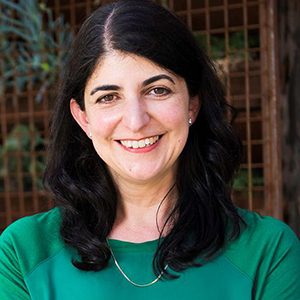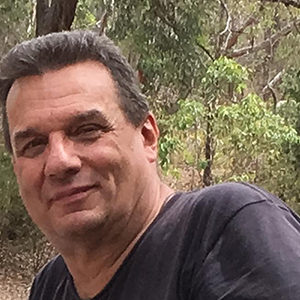Hedonism features seven galleries hosting different interactive exhibits to help you find new ways to contribute to your own lifelong journey of pleasure and wellbeing.
But have you ever stopped to ask yourself why some of the simplest things in life, such as food and music, are intrinsically enjoyable?
In the stories below, we ask a range of experts from UniSA and beyond, what it is about certain activities – food, music, exercise and pairing up – that makes them so pleasurable.
Once you’ve taken that in, you might want to visit MOD.’s most ambitious exhibition yet – Hedonism.
 MOD. Director Dr Kristin Alford says Hedonism highlights the parameters that make pleasure more possible and more sustainable.
MOD. Director Dr Kristin Alford says Hedonism highlights the parameters that make pleasure more possible and more sustainable.
“It’s a highly interactive exhibition and because it is so focused on what makes us happy – happy at work, happy with our hobbies and sports, happy in our social connections, healthy and happy – I think there is something for everyone to enjoy and be curious about,” Dr Alford says.
“These are significant questions because despite our wealth and health, our happiness is not guaranteed in modern affluent communities.
“Interrogating pleasure in a philosophical context – where we look at the original notion of hedonism and see how we balance our lives to ensure maximum happiness is important.”
MOD. is located on North Terrace, Adelaide, and is open every day except Mondays. Visit mod.org.au

BY MICHÈLE NARDELLI
It is no surprise that a signature tune in the musical adaptation of Oliver Twist is about food.
 Food was a preoccupation in Dickensian England. For the haves – glorious golden turkey, glistening plum puddings, red-hot chestnuts and luscious pears, and for the have-nots – dirty scraps of bread, watered down milk, and grisly bowls of thin gruel. UniSA’s Professor Tim Olds’ research into children’s diets across history, reveals that before 1800, the standard diet for children in the UK was essentially bread and small beer (ale with an almost soupy consistency but less alcohol than regular beer).
Food was a preoccupation in Dickensian England. For the haves – glorious golden turkey, glistening plum puddings, red-hot chestnuts and luscious pears, and for the have-nots – dirty scraps of bread, watered down milk, and grisly bowls of thin gruel. UniSA’s Professor Tim Olds’ research into children’s diets across history, reveals that before 1800, the standard diet for children in the UK was essentially bread and small beer (ale with an almost soupy consistency but less alcohol than regular beer).
While not in tune with modern notions of good health and fitness, you’ve got to love the line from the song Food, Glorious, Food that goes “just thinking of growing fat, my senses go reeling” – because as we all know intuitively, the love of food is about much more than flavour and nutrition.
New research is indicating that enjoyment of food goes well beyond single senses – such as taste, smell, texture (touch) and sight.
It is the interplay of all the senses with other responses to different stimuli that make up quite complex human attitudes to food – responses that involve our surroundings and our emotional and cultural conditioning too.
Unpacking food attraction and food experience factors has spurred the new study of gastrophysics. It is inspiring thousands of hours of marketing research to ensure the packaging, marketing and consumer experience of foods are the best they can be.
Did you know, for example, that plain unsweetened yoghurt will always taste sweeter to consumers when it is coloured pink? Similarly, wine in a heavier bottle will be considered better quality; and crisps from more “noisy” bags will be experienced as fresher.
UK expert in multisensory perceptions, author of the book – Gastrophysics; the New Science of Eating – and a visiting researcher to UniSA in 2018, Professor Charles Spence, believes the real pleasures of the table “reside in the mind, not in the mouth”.
“If you get that straight, it soon becomes clear why cooking, no matter how exquisitely executed, can only take you so far,” Prof Spence says in his book.
“One needs to understand the role of ‘the everything else’ in order to determine what really makes food and drink so enjoyable, stimulating and, most importantly, memorable.”
UniSA researchers are taking these ideas and applying them to new projects set to make an impact beyond how a restaurant is styled or packaging is designed.
 Dr Richard Lee from UniSA’s School of Marketing is working on a study with industry partners that will look at how to improve the enjoyment of eating for elderly residents in nursing homes.
Dr Richard Lee from UniSA’s School of Marketing is working on a study with industry partners that will look at how to improve the enjoyment of eating for elderly residents in nursing homes.
“Understanding what helps to enhance appetite and make eating pleasurable has the potential to deliver significant health benefits to older people,” Dr Lee says.
“It could be a combination of factors from how the food is presented right through to the ambience of the eating environment that makes a difference and our research will set out to find evidence for what makes an impact on the residents eating well.
“In the first instance we may look at variables like changing the colour of the dining accessories, putting infographic cards, or some sort of mealtime activities on tables to encourage residents to interact while they are dining, to see if and how it changes their eating patterns.”
UniSA Honorary Doctor and passionate advocate for quality, healthy, seasonal cooking Maggie Beer, believes it is vital to maintain the culture of eating well.
The Maggie Beer Foundation, established in 2014, aims to improve food experiences for older Australians, particularly those living in aged care homes.
Understanding food as an experience is a hint to the transformation Beer is hoping for.
“Food is the fuel of life,” Beer says.
“Its substance is far more than just the nutrients acquired in the act of eating. It’s the loving preparation, the anticipation of sharing a beautifully cooked and presented meal and the delicious pleasure of engaging all our senses as we eat. Food is nutrition not just for the body, but also for the soul. It’s what fires our appetite for life, no matter what age.
“I believe if we bring these values to meal times in aged care settings, we can improve the quality of life for all residents nutritionally but also emotionally and socially.”
We know the close link between appetite and life is fundamental across cultures.
 UniSA Program Director for Nutrition and Food Sciences, Dr Evangeline Mantzioris, says it is interesting that every culture seems to have that one dish that can be described as “soul food”.
UniSA Program Director for Nutrition and Food Sciences, Dr Evangeline Mantzioris, says it is interesting that every culture seems to have that one dish that can be described as “soul food”.
“In my culture it is a style of lentil soup that nourished families in Greece during WWII when food was scarce; in Australia it might be that classic roast lamb and veggies, the one you’d pass up a date with Tom Cruise for,” Dr Mantzioris says.
She believes that if you look at those soul foods, the chicken soup, the hearty casseroles, along with a good chunk of bread – more often than not – they are balanced and nutritious.
“When people engage with the culture of food, preparing food, thinking about and shopping for ingredients, they tend to prepare foods that are wholesome.”
“Eating well is all about balance – a mix of proteins and carbohydrates, fruits, vegetables, legumes and pulses – and research backs this up. Eliminating food groups from the diet is really not the answer.
“Young or old, healthy eating has to be about good nutrition but also the elements of eating that both excite and satiate the appetite.
“It is also about the balance between eating too much or too little and that is a challenge we face across our lifetime – to develop a sustainable diet that will keep us and our environment healthy.”
Across cultures, measures of success and happiness have often been interwoven with notions of a full table.
As Virginia Woolf once remarked: “One cannot think well, love well and sleep well, if one has not dined well.”
But today, as the world’s richest Western nations are challenged by obesity and its related health problems, our relationship with food has become as fractured as the myriad diets being promoted – paleo; low-fat; no-sugar; the five-two fasting – the list goes on.
So, while we eschew fats and fatness, we dine on television shows about combatant chefs serving three-course meals with all the condiments and in the ad breaks, consider the virtues of packaged diet meals delivered to our doors.
As a society, when we consider food in all its glory, we probably need to find the fabled Goldilocks spot – where everything is just right.
Find out more
Study Nutrition and Food Sciences at UniSA.
 BY DAN LANDER
BY DAN LANDER
What is it about rhythm and melody that humans find so irresistible?
Science is a little uncertain about the extent to which music exists in the animal kingdom. Sure, birds and whales sing, but we don’t really know if they’re creating music per se. Similarly, elephants appear to dance but there is plenty of debate about the extent to which they can actually follow a beat. Many dogs are soothed by orchestral classics (cats, appropriately, seem completely indifferent to music) and in one rather bizarre study, fish could seemingly tell the difference between Stravinsky and Bach, although nobody knows if this was musical discretion or something else.
What is clear however, is the extent to which humans are extraordinarily musical in comparison to other species. Parrots – widely regarded as one of the most intelligent animals on the planet – are our nearest rivals in music, able to learn a few simple tunes and hit a beat with about 25 per cent accuracy. Some humans, on the other hand, can keep almost perfect rhythm and compose symphonies in their head. Why? We don’t know, but we do have some theories …
Approaching doom
 UniSA Adjunct Professor Jon Stratton is a cultural theorist and popular music expert, and while he stops short of asserting that every human culture has created music, he believes it is very likely the case.
UniSA Adjunct Professor Jon Stratton is a cultural theorist and popular music expert, and while he stops short of asserting that every human culture has created music, he believes it is very likely the case.
“At least, I can’t name a culture that disproves the theory that music is something we all have in common,” Prof Stratton says. “Historically, many people have argued that music began as we became human, as we took that evolutionary step. And so, in a way, music equates with the idea of ‘humanness’.”
At its most basic, this human thing we call music consists of two elements: rhythm, which refers to the temporal organisation of sound and silence into recognisable patterns; and melody, the coherent arrangement of contrasting frequencies.
Rhythm can exist without melody – banging your foot on the floor a few times will do. Melody, however, cannot exist without rhythm, as oscillating between different frequencies will simultaneously create a rhythmic pattern.
This rhythmical primacy has long been noted, and as far back as 1893, British ethologist and psychologist Conwy Lloyd Morgan observed: “We cannot walk nor breathe except to rhythm.”
This, in turn, has led to suggestions our ability to focus on a rhythm – known as entrainment – may have developed as a survival mechanism. To recognise a regular pattern as the footsteps of a predator would be an evolutionary boon; even more so to recognise when that pattern is speeding up, which may indicate an imminent attack.
Similarly, some research suggests the ability to synchronise our movements to a rhythm may be evolutionarily advantageous. People walking together will unconsciously match steps, a phenomenon that researchers believe may have helped early humans create less noise when travelling as a group, making them both harder to detect and better able to hear what was going on around them.
The language of love
Explaining melody in evolutionary terms is a little trickier. Harvard psychologist Professor Steven Pinker once described music as “auditory cheesecake”, arguing it is pleasurable but pointless, and suggesting that even if there are primal advantages to rhythmic entrainment, the emotional response we have to the melodic themes of our favourite music is evolutionarily irrelevant.
Not everyone agrees with Prof Pinker, starting with Aristotle, who speculated we respond emotionally to music because of the way it mimics our cries of pain or sighs of joy, painting it as a form of onomatopoeic communication. Charles Darwin concurred, suggesting in 1871:
“It appears probable that the progenitors of man, before acquiring the power of expressing their mutual love in articulate language, endeavoured to charm each other with musical notes and rhythm.”
Prof Stratton suggests, many millennia later, this primal intimacy inherent in music is key to its enduring appeal. In a manner more mysterious, and possibly more powerful, than verbal language, music allows people to co-experience emotion.
“Music can create a shared energy,” Prof Stratton says. “Whether that is in religious ritual or the songs of the civil rights movement or a modern concert, music allows people to unite, to experience something together, and in doing so, it creates a bond between those who share it.”
This experience often goes far beyond the explicit meaning of a song or its value as entertainment. According to philosopher and composer Leonard Meyer, music manipulates our expectations, encouraging subconscious predictions about patterns and forms. When we correctly predict the pattern, we feel pleasure, and studies show the brain releases dopamine at key points in a musical piece, be it catchy chorus or crashing crescendo.
The musical patterns we respond to, however, are not universal, but vary from culture to culture, and we learn them as we are enculturated. This process explains why, for all music’s apparent universality, it is also stunningly diverse, and why a combination of rhythm and melody comforting to one person can be confronting to another.
“This is why you see different forms of music emerge that are distinct to a particular culture,” Prof Stratton says. “For instance, ‘pub rock’ is a distinctly Australian sound, little appreciated outside Australia. It reflects the isolation and ‘whiteness’ of the culture that produced it – it’s still rock music, but without a lot of the ‘black’ influence that has shaped similar forms in the US and the UK.
“And it’s interesting to note as Australian society has become more diverse in recent years, so too the dominance of pub rock as our ‘national sound’ has declined.”
It’s a group thing
 Professor Michelle Baddeley, from UniSA’s Institute for Choice, is an expert on group dynamics, and notes that while our responses to music may be culturally conditioned, they are also consistent with much of human social behaviour. With music, as with many other things, we usually match our tastes to those of our nearest and dearest.
Professor Michelle Baddeley, from UniSA’s Institute for Choice, is an expert on group dynamics, and notes that while our responses to music may be culturally conditioned, they are also consistent with much of human social behaviour. With music, as with many other things, we usually match our tastes to those of our nearest and dearest.
“Mostly, we like what the rest of our ‘group’ likes,” Prof Baddeley says. “Freud noted our need to belong to a group, and in our unconscious minds, opposing the herd is as bad as separating from it, and separation generates extreme anxiety. Our sense of identity and social belonging will also determine our response to music. To some people ABBA’s music is cool, for others ABBA’s music is only loved by dags. It all depends on what your group likes.”
This social dimension can lend music emotional connotation far beyond any intrinsic response to rhythm and melody, and as Prof Baddeley says, this is often conflated with concepts of idolatry and devotion to fuel extreme connections.
“Sometimes music can trigger seemingly irrational behaviours,” Prof Baddeley says. “Frenzied fandom – an enduring feature of our responses to musicians – is famously associated with Beatlemania, but Lisztomania is a similar episode. After his concerts in Berlin in 1841, crowds of Liszt’s fans mobbed him and fought over his jewellery and clothes.”
While such reactions may seem out of proportion and even a little inappropriate to some, they’re also a powerful reminder of music’s ability to connect people. The real challenge, as Prof Stratton sees it, lies in fostering such connections beyond our social groups and cultural boundaries.
“So much music is available now, and this has led, ironically, to increasing divisions and specialisations within genres, so people often only listen to highly limited areas of the mass of available music. But, when people do listen outside their comfort zone, every so often they go, ‘wow, that’s amazing, I didn’t know that existed’. And that can produce a kind of cultural awakening.”

BY ADAM JOYCE
Why does sex give us pleasure and relationships make us happy (well, sometimes)?
Let’s Do It (Let’s Fall in Love)
By Ella Fitzgerald
Birds do it, bees do it
Even educated fleas do it
Let’s do it, let’s fall in love
Why do humans enjoy coupling up?
The obvious answer relates to reproduction. We want sex because our continued existence as a species depends on it. And relationships support child-rearing and hence, the perpetuation of your genes.
While genetic evolution provides an important biological explanation for why humans experience pleasure, joy and happiness from both intimate physical and emotional contact with others, to focus on this does a disservice to the human experience and the meaning we find in life.
 Adjunct Senior Lecturer in UniSA’s School of Psychology, Social Work and Social Policy, Dr Phil Kavanagh, says that although love can be linked back to the survival of the species and the prospect of children, there are many other rewards we get from being in a romantic relationship.
Adjunct Senior Lecturer in UniSA’s School of Psychology, Social Work and Social Policy, Dr Phil Kavanagh, says that although love can be linked back to the survival of the species and the prospect of children, there are many other rewards we get from being in a romantic relationship.
“Some of the benefits include having someone to talk to, having better access to help, being able to bond with someone, divvying up problems, improved physical and mental health and social support,” he says. “Relationships, generally, benefit our health.”
Meanwhile, the development of and improved access to contraceptives, combined with changing cultural attitudes, means that most sex between humans is more often about connecting with other people than reproduction.
“The underlying driver is whether you want to bond with someone,” Dr Kavanagh says. “Humans are social animals. We are not so good at surviving by ourselves. We need one another for protection against disease and diverse genetic material.
“When it comes to love, there are lots of theories. It’s an emotion that helps bond people together. It allows us to maintain long term relationships for our survival. As individuals and a group, it is linked back to survival of the species. With every organism, it comes down to survival and reproduction. You can’t have one without the other.”
Sex can also lead to bonding. During and after sex, chemicals are released that create a type of bond.
“When you do any exercise, from having sex to riding a bike or running, dopamine (associated with motivation and desire) gets released,” Dr Kavanagh says.
Other chemicals create a type of bond.
“The ‘feel good aspect’ is oxytocin, a hormone released after people have sex. It’s also known as the attachment or bonding hormone because it’s also released when a mother is breastfeeding her baby. The theory is that it allows for bonding.”
A surge in oxytocin occurs when we see family members, are romantically attracted to someone, or are shown an enormous kindness.
Although most people think a successful relationship requires sex, research examining heterosexual relationships suggests this isn’t always the case.
“As people get older, they move away from passionate love to more companionate love, more like a long-term best friend. So, yes, it’s possible to have a successful relationship without sex.
“The key to a successful relationship is that both people need to have their needs met. That is not necessarily sexual – it could be intimacy. The key reasons for a breakdown are lack of reciprocity.”
Both partners need to contribute in an equivalent way for the relationship to continue successfully.
While it’s normal for a partner to be a major source of joy and happiness, things cross the line if you depend on your partner for happiness. A healthy relationship requires some degree of independence — which includes having sources of joy outside the relationship.
So what attracts us to another person in the first place, whether for sex or something longer term?
In physical terms, it comes down to indicators of good health.
“Men in general tend to pursue women who have high levels of fertility, for example, they are healthy, have good looking skin, are a healthy weight and have a waist to hips ratio that supports child bearing,” Dr Kavanagh says. “This is consistent across cultures. This is a marker of fertility.”
Whereas the physical attractiveness of men is driven by their shoulder to waist ratio.
“Ideally you have broad shoulders in comparison to your waistline,” Dr Kavanagh says “These are all proxies for health and fitness. If you’re overweight then it’s going to be harder to have kids, harder to do physical activity, to work, live and have a long life. These are all health markers.”
However, what people find physically attractive can be modified by cultural variations.
“For example, some cultures place an emphasis on how many lip rings you have – a status symbol of sorts. This serves no purpose genetically. Some cultures prefer a specific skin tone, which has nothing to do with reproduction.”
Physical attraction can also be overridden by personality.
“The person has got to get your attention in some way – whether personality or how they look,” Dr Kavanagh says. “People can learn to become physically attracted over time due to something to do with their personality or a bond may develop.”
Despite the popularity of the phrase, human evolution does not come down to “survival of the fittest”.
“It’s the non-survival of the non-fittest,” Dr Kavanagh says. “It’s not about being faster than the lion – you have to be faster than the slowest person. The key is to be in the general pack. You don’t have to be the best and the biggest.
“The stuff that doesn’t allow you to survive, gets you selected out. Mating, and what we’re attracted to, comes back to indicators of health.”
In addition to attraction, there are two other key factors that determine how humans select a mate or partner:
1. Proximity - you need to live close enough for it to be practicable (although the internet has overcome distance to some degree, long-distance relationships remain fraught).
2. Similarities – the more you have in common such as political religious and moral beliefs, interests, level of education and intelligence, personality type, and level of attractiveness, the more likely the relationship is to work.
“Of course there are lots of competing theories,” Dr Kavanagh says. “Some researchers have based their whole careers on mating – so this is a simple summary of a complex topic.”

BY ADAM JOYCE
Long bouts of aerobic exercise can induce feelings of euphoria but even small amounts of physical activity can bring pleasure.
Why do some people love exercising while others find it a chore? It comes down to finding a physical activity you enjoy – and that activity will be different for each person.
 UniSA Lecturer in Human Movement: Exercise and Sport Psychology
UniSA Lecturer in Human Movement: Exercise and Sport Psychology
Dr Alyson Crozier says despite what some people think, there is an enjoyable form of physical activity for everyone. The key is to keep trying different ones until you find one that you like, so that you’ll keep it up.
“If you find something you enjoy, you will make time for it,” Dr Crozier says. “Don’t go for a run because you’re told to. It really is about past experiences – if you do something you enjoy, that is going to make it more enjoyable next time. A negative experience will make you more hesitant and affect your feelings about it.
“Ideally you should try and find an activity that you don’t have to think about, it just becomes part of your day – such as taking the dog for a walk. And get your family or friends involved – social support really helps. You are choosing whatever you want to do and doing it with people that you enjoy being with.”
So why do people get joy from exercise?
“There are a range of theories about the appeal of exercising with other people, including that it fulfils a psychological need to belong and to be connected to others. People who love team sports often cite being part of the team as key to the joy of their sport,” Dr Crozier says.
The more cohesive a sporting team is – united in striving for team goals as well as getting along socially – and the more the team members see themselves as a group, with clear roles, expectations and mutual respect, the more likely the participants will continue to play team sport.
But social physical activity isn’t restricted to team sports, you might have a jogging partner, cycle with friends or go to an exercise class.
“It brings enjoyment and involving other people can help keep you accountable. But of course, there are many people who prefer to do things alone – it’s important to find something that works for you,” Dr Crozier says.
Dr Crozier also says there are other psychological benefits to doing something challenging, such as learning something new, the satisfaction from working well with others in a group, and a general sense of accomplishment.
What’s happening biologically?
As well as contributing to a sense of enjoyment and accomplishment, the neurotransmitters released during exercise have other benefits. When you exercise, your body releases hormones called endorphins, which reduce your perception of pain. Exercise also causes your body to release a chemical called dopamine, which creates feelings of pleasure and reward. Endorphins are produced in response to physical discomfort, but as Dr Crozier is quick to point out, that doesn’t mean exercise should be excruciating; you need to find a sweet spot where it is comfortably challenging. In addition, an Oxford University study reported that rowers who exercised together significantly increased their endorphin release compared with solo rowers.
“Physical activity is good for your mental health. There’s lots of research – whole journals – that show exercise has a positive effect and can be just as effective – although not always – as anti-depressant medications,” Dr Crozier says. “There is a push to have MDs refer patients to professionals, like clinical exercise physiologists, that can prescribe exercise as part of a plan for treating particular conditions.”
Exercise is known to reduce anxiety and depression, improve general wellbeing, self-esteem and self-image.
Norepinephrine secretion, dopamine, and serotonin have all been shown to help to reduce depression. These neurotransmitters tend to be released and produced in higher concentrations during exercise.
After a long bout of aerobic exercise, some people experience “flow”: a feeling of euphoria coupled with reduced anxiety and a lessened ability to feel pain. Runners call it “runner’s high”.
“To be ‘in the flow’, you have to be sufficiently challenged by what you’re doing; and you have to enjoy it when you’re doing it,” Dr Crozier says. “Flow is a sort of trance where you are doing everything automatically.”
Once you reach this state, which generally requires being active for 30 minutes or more at a moderate intensity level, people often lose track of time.
Whether it’s swimming, cycling or rowing, the key to the high is repetition – things you can perform in a repetitive, rhythmic fashion.
“As you reflect on what you’ve done, chemicals continue to be released,” she says. “That feeling of enjoyment can last for hours. These chemicals are typically released for up to two hours but sometimes the feeling can last until the next day.”
There are evolutionary reasons for this – good physical health was once essential for survival. Although survival is no longer the driver, the pleasure exercise brings remains a key motivator to staying healthy.
Find out more
Alliance for Research in Exercise, Nutrition and Activity (ARENA)
Study Exercise and Sport Science at UniSA